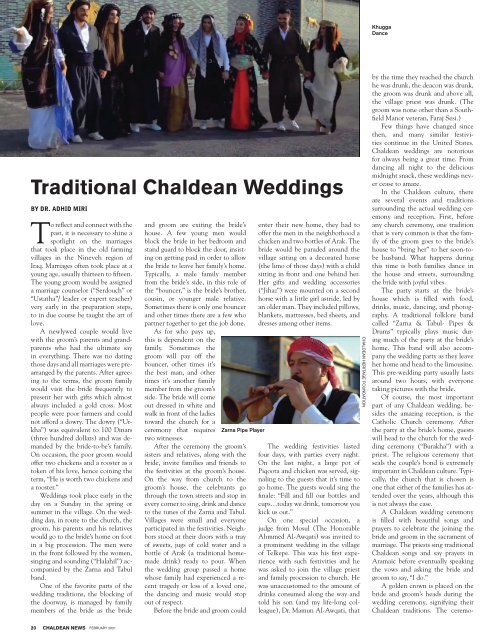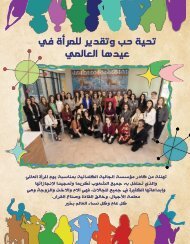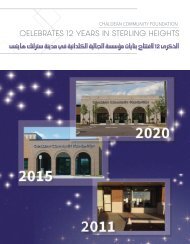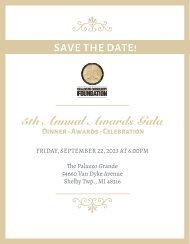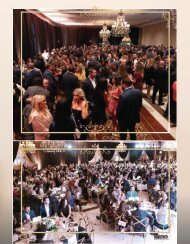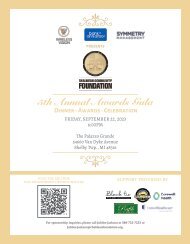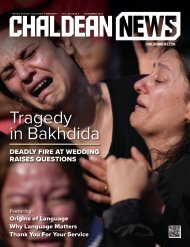FEBRUARY 2021
Create successful ePaper yourself
Turn your PDF publications into a flip-book with our unique Google optimized e-Paper software.
Khugga<br />
Dance<br />
Traditional Chaldean Weddings<br />
BY DR. ADHID MIRI<br />
To reflect and connect with the<br />
past, it is necessary to shine a<br />
spotlight on the marriages<br />
that took place in the old farming<br />
villages in the Nineveh region of<br />
Iraq. Marriages often took place at a<br />
young age, usually thirteen to fifteen.<br />
The young groom would be assigned<br />
a marriage counselor (“Serdouch” or<br />
“Ustatha”/ leader or expert teacher)<br />
very early in the preparation steps,<br />
to in due course be taught the art of<br />
love.<br />
A newlywed couple would live<br />
with the groom’s parents and grandparents<br />
who had the ultimate say<br />
in everything. There was no dating<br />
those days and all marriages were prearranged<br />
by the parents. After agreeing<br />
to the terms, the groom family<br />
would visit the bride frequently to<br />
present her with gifts which almost<br />
always included a gold cross. Most<br />
people were poor farmers and could<br />
not afford a dowry. The dowry (“Urkha”)<br />
was equivalent to 100 Dinars<br />
(three hundred dollars) and was demanded<br />
by the bride-to-be’s family.<br />
On occasion, the poor groom would<br />
offer two chickens and a rooster as a<br />
token of his love, hence coining the<br />
term, “He is worth two chickens and<br />
a rooster.”<br />
Weddings took place early in the<br />
day on a Sunday in the spring or<br />
summer in the village. On the wedding<br />
day, in route to the church, the<br />
groom, his parents and his relatives<br />
would go to the bride’s home on foot<br />
in a big procession. The men were<br />
in the front followed by the women,<br />
singing and sounding (“Halahil”) accompanied<br />
by the Zarna and Tabul<br />
band.<br />
One of the favorite parts of the<br />
wedding traditions, the blocking of<br />
the doorway, is managed by family<br />
members of the bride as the bride<br />
and groom are exiting the bride’s<br />
house. A few young men would<br />
block the bride in her bedroom and<br />
stand guard to block the door, insisting<br />
on getting paid in order to allow<br />
the bride to leave her family’s home.<br />
Typically, a male family member<br />
from the bride’s side, in this role of<br />
the “bouncer,” is the bride’s brother,<br />
cousin, or younger male relative.<br />
Sometimes there is only one bouncer<br />
and other times there are a few who<br />
partner together to get the job done.<br />
As for who pays up,<br />
this is dependent on the<br />
family. Sometimes the<br />
groom will pay off the<br />
bouncer, other times it’s<br />
the best man, and other<br />
times it’s another family<br />
member from the groom’s<br />
side. The bride will come<br />
out dressed in white and<br />
walk in front of the ladies<br />
toward the church for a<br />
ceremony that requires<br />
two witnesses.<br />
After the ceremony the groom’s<br />
sisters and relatives, along with the<br />
bride, invite families and friends to<br />
the festivities at the groom’s house.<br />
On the way from church to the<br />
groom’s house, the celebrants go<br />
through the town streets and stop in<br />
every corner to sing, drink and dance<br />
to the tunes of the Zarna and Tabul.<br />
Villages were small and everyone<br />
participated in the festivities. Neighbors<br />
stood at their doors with a tray<br />
of sweets, jugs of cold water and a<br />
bottle of Arak (a traditional homemade<br />
drink) ready to pour. When<br />
the wedding group passed a home<br />
whose family had experienced a recent<br />
tragedy or loss of a loved one,<br />
the dancing and music would stop<br />
out of respect.<br />
Before the bride and groom could<br />
Zarna Pipe Player<br />
enter their new home, they had to<br />
offer the men in the neighborhood a<br />
chicken and two bottles of Arak. The<br />
bride would be paraded around the<br />
village sitting on a decorated horse<br />
(the limo of those days) with a child<br />
sitting in front and one behind her.<br />
Her gifts and wedding accessories<br />
(“Jihaz”) were mounted on a second<br />
horse with a little girl astride, led by<br />
an older man. They included pillows,<br />
blankets, mattresses, bed sheets, and<br />
dresses among other items.<br />
The wedding festivities lasted<br />
four days, with parties every night.<br />
On the last night, a large pot of<br />
Piqoota and chicken was served, signaling<br />
to the guests that it’s time to<br />
go home. The guests would sing the<br />
finale: “Fill and fill our bottles and<br />
cups…today we drink, tomorrow you<br />
kick us out.”<br />
On one special occasion, a<br />
judge from Mosul (The Honorable<br />
Ahmmed Al-Awqati) was invited to<br />
a prominent wedding in the village<br />
of Telkepe. This was his first experience<br />
with such festivities and he<br />
was asked to join the village priest<br />
and family procession to church. He<br />
was unaccustomed to the amount of<br />
drinks consumed along the way and<br />
told his son (and my life-long colleague),<br />
Dr. Mamun Al-Awqati, that<br />
CHALDEAN HERITAGE FOUNDATION<br />
by the time they reached the church<br />
he was drunk, the deacon was drunk,<br />
the groom was drunk and above all,<br />
the village priest was drunk. (The<br />
groom was none other than a Southfield<br />
Manor veteran, Faraj Sesi.)<br />
Few things have changed since<br />
then, and many similar festivities<br />
continue in the United States.<br />
Chaldean weddings are notorious<br />
for always being a great time. From<br />
dancing all night to the delicious<br />
midnight snack, these weddings never<br />
cease to amaze.<br />
In the Chaldean culture, there<br />
are several events and traditions<br />
surrounding the actual wedding ceremony<br />
and reception. First, before<br />
any church ceremony, one tradition<br />
that is very common is that the family<br />
of the groom goes to the bride’s<br />
house to “bring her” to her soon-tobe<br />
husband. What happens during<br />
this time is both families dance in<br />
the house and streets, surrounding<br />
the bride with joyful vibes.<br />
The party starts at the bride’s<br />
house which is filled with food,<br />
drinks, music, dancing, and photography.<br />
A traditional folklore band<br />
called “Zarna & Tabul- Pipes &<br />
Drums” typically plays music during<br />
much of the party at the bride’s<br />
home. This band will also accompany<br />
the wedding party as they leave<br />
her home and head to the limousine.<br />
This pre-wedding party usually lasts<br />
around two hours, with everyone<br />
taking pictures with the bride.<br />
Of course, the most important<br />
part of any Chaldean wedding, besides<br />
the amazing reception, is the<br />
Catholic Church ceremony. After<br />
the party at the bride’s home, guests<br />
will head to the church for the wedding<br />
ceremony (“Burakha”) with a<br />
priest. The religious ceremony that<br />
seals the couple’s bond is extremely<br />
important in Chaldean culture. Typically,<br />
the church that is chosen is<br />
one that either of the families has attended<br />
over the years, although this<br />
is not always the case.<br />
A Chaldean wedding ceremony<br />
is filled with beautiful songs and<br />
prayers to celebrate the joining the<br />
bride and groom in the sacrament of<br />
marriage. The priests sing traditional<br />
Chaldean songs and say prayers in<br />
Aramaic before eventually speaking<br />
the vows and asking the bride and<br />
groom to say, “I do.”<br />
A golden crown is placed on the<br />
bride and groom’s heads during the<br />
wedding ceremony, signifying their<br />
Chaldean traditions. The ceremo-<br />
20 CHALDEAN NEWS <strong>FEBRUARY</strong> <strong>2021</strong>


